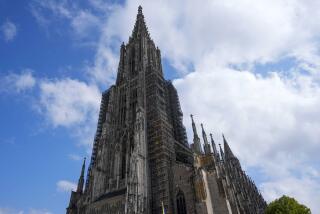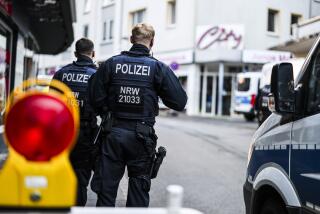Europeâs sleeping beauty
Cologne, Germany â WHEN we told people we were going to Germany for our summer vacation, the universal response was, âOh, youâre going for the World Cup. Cool.â
When we explained that no, actually, we had timed our trip to miss the World Cup, with all its ancillary hotel and traffic jams, our friends looked at us with mild bewilderment and asked, âThen why are you going to Germany?â
Tell someone youâre going to Italy, France, London, Ireland, Prague or Vietnam and theyâll nod with envy -- lucky you. But unless youâre off to Munich for Oktoberfest or Berlin for the film festival, Germany is a cipher -- for Americans anyway -- trailing Mexico, Canada, Britain, France, China and Italy as an international tourist destination.
We came to Germany because we have good friends who are German, and we thought it would be fun to learn about their country the way they have learned about ours. Some of what we learned during almost three weeks of our German summer:
* The landscape is as green and pastoral as Ireland with, at least in the areas we visited, castles everywhere you look.
* Likewise, the landscape is dotted with vineyards, Roman ruins and medieval cities just like in Italy.
* The people, though not unfriendly, are reserved, which may seem at odds with their penchant for beer gardens and public nudity -- itâs legal here.
* The food is not for the faint of heart, relying on cured meats, cheeses, pork and a variety of tasty but heavy sauces.
* You may never again be able to settle for an American pretzel or even American bread.
Because we were traveling with four young children, ranging in age from 6 to 12, we decided to save Berlin for another trip and concentrate on outdoor and medieval Germany.
The two families were to meet in Cologne, travel southwest along the Moselle Valley and then pick up the Romantic Road, which runs through western Bavaria. We would spend a week in a Bavarian farmhouse before parting -- they to Stuttgart, we to Munich, where my cousin and her family had recently moved.
Cologne is a busy, mostly modern city, so after meeting at the famous Cologne Cathedral, we pushed on to our first real destination: Koblenz, which, situated at the confluence of the Moselle and Rhine rivers, is considered the gateway to the romantic Rhine.
We stayed one night at a Pension outside of town, where we learned a valuable lesson: Eat dinner in beer and wine gardens because German restaurants are mostly very quiet, and beer and wine gardens often have a play area for the kids.
Koblenz is a lovely little city, but we spent most of our time there exploring the Ehrenbreitstein, a fortress overlooking both rivers that has been in place since pre-Roman times. A visit to the fortress, which contains a hostel, a restaurant and two museums, could occupy most of a day. In its Landesmuseum, artifacts from local digs chronicle the area from prehistoric times through the Celts, Romans and early Germans, which was fascinating.
From Koblenz we drove through the Moselle Valley to Trier. If we have one regret about our trip, itâs that we didnât spend enough time in the Moselle Valley, which is one of the most beautiful places Iâve ever seen. Hills green with forests and steep vineyards cradle the twisting river. Castle ruins rise from the greenery like a Romanticistâs dream as one charming town after another beckons with geranium-frilled windows and shady cafes.
Trier is one of the oldest cities in Germany, anchored by the Porta Nigra (Black Gate), the ruins of the 2nd century fortification that surrounded what was then a Roman outpost. We took a two-hour walking tour with a guide supplied by the tourist office (we told them we had young children), and she, and the town, were so interesting that the kids didnât start whining until about five minutes before the end. Miraculous.
Roman ruins dot the city, including an amphitheater and ancient baths, recently restored. The Roman Emperor Constantine spent some time here, building an awe-inspiring throne hall that is now a Protestant church, as well as a series of baths that are still being excavated. A more modern figure, Karl Marx, was born here; his house, now a museum, details the rise and fall of Marxism and Communism. (All exhibits are in German, but there is an English audio tour.)
*
Cool sites for a kid
FROM Trier, we headed southeast to Bruhl, a small town outside Heidelberg, where our friendâs mother had kindly offered to put us all up. There we learned a very helpful thing about German towns: Many of them have terrific public swimming pools. Although I hope my kids remember the various castles, parks, ruins and trails we visited in Germany, I know they will remember the super-cool waterslide in Bruhl.
Heidelberg is, of course, wonderful and magical, with its lovely bridges, medieval streets and an old-world university feel. We took the funicular up to the Schloss, the Gothic-Renaissance fortress that looms over the red roofs in semi-ruined magnificence. Then we walked down more than 300 steps. The thing about medieval hill towns is that they usually have a lot of stairs, which is worth noting when you are six monthsâ pregnant.
Heidelbergâs popular Philosopherâs Walk, which wends its way through vineyards and orchards in the hills on the other side of the Neckar River, should be called the Philosopherâs Hike, because the first part is pretty much straight uphill. But the view, especially at sunset, is incomparable, and mercifully, there are benches.
The two families split for a few days and ours went in search of the Romantic Road, which runs through two dozen mostly medieval towns in western Bavaria from Wurzburg to Fussen. On our own, we got lost but wound up at the Burg Hornberg, a fascinating ruined castle on a hill above the Neckar River that dates back to the 11th century. It was worth the detour.
We traveled about two-thirds of the route and found little to call romantic about the actual road, though some of the towns were pretty remarkable.
We stayed in the town of Rothenburg ob der Tauber despite our friendsâ warning that it is seriously touristy. (It was, but hey, we were tourists.) The winding cobblestone streets and quaint old houses with their flower-bedecked windows pretty much define âpicturesqueâ and are about as far from modern Los Angeles as you can get. Ice cream shops abound, as do bakeries selling Schneeballen, strips of dough rolled in a ball and coated in sugar (or chocolate or just about anything sweet), and there are several playgrounds at regular intervals just outside the city walls.
Most of the original city walls are still intact and you can walk along the top of them, peering down at the city like a night watchman of old. There is, in fact, a truly fabulous night-watchman tour, given by Hans Georg Baumgartner, who is funny and informative about the city, which, decimated during the 17th century Thirty Yearsâ War, has survived on tourism since the 18th century.
We were in Rothenburg during a Historisches Festspiele âDer Meistertrunkâ(Historic Festival performance of âThe Master Potionâ), when the entire town participates in a three-hour play about the Thirty Yearsâ War. Because it was so long, and in German, we didnât think the kids would sit through the performance, held for several evenings in the main square, but there really was no need to attend.
From the late afternoon into the night, costumed players roamed the city. A pageant of German history passed us wherever we went, thrilling the kids and making the town seem that much more otherworldly.
A little farther south is Dinkelsbuhl, another walled medieval town that is very charming but much less touristy. Here we regrouped with our friends. Sadly, we arrived at the end of the 10day Kinderzeche (Childrenâs Festival), though we were able to catch a wonderful local dance exhibition one evening in the main square and a childrenâs play at the local amphitheater. (It was in German, but the cast was so physically expressive that Danny, 8, and Fiona, 6, got the gist of the plot and most of the jokes.)
Dinkelsbuhl too has a night-watch tour, though it was pretty much a bust (the watchman goes from bar to bar singing songs in praise of Dinkelsbuhl and getting a free drink in return), but here we could finally rent bikes. We spent a day riding along the outside of the wall, finding little playgrounds as we went, as well as a pond with baby ducks and a âwall ghost,â or at least thatâs how a small dark window in the wall just beside one of the city gates was marked. Peeking into its depths, it was easy to imagine some tormented soul trapped there.
After so much moving around, we were happy to get to the farmhouse apartment we had rented for a week in Bavaria. Part of a lodge that includes a restaurant open during ski season, it is situated in Buchenberg, which is smack dab in the middle of nowhere -- the directions from the nearest âbig townâ of Kempten donât even bother using street names but tell you instead to âturn left at the house with the green shutters.â It is, however, some of the most gorgeous ânowhereâ you will ever see.
The locals, our friends informed us, consider themselves Bavarians first and Germans second, and it was easy to see why. As beautiful as some of the scenery was that we had passed through, this pretty much defined âidyllic.â Rolling green hills are populated by limpid-eyed cows whose bells seem to transport you to the winter-white Alps dazzling in the distance; spiky fir forests ring wide blue lakes; the spires of small-town churches rise into a cloud-fleeced blue sky. It was more like a painting than a place. So quiet. And such fresh air. It really was all you could do to keep from running through the convent gates, shedding your novitiateâs headdress and twirling musically in the fields of green like Julie Andrews in âThe Sound of Music.â (Wait, that was Austria but, at less than 50 miles away, close enough.)
We swam in the lake, we hiked in the forests, we drove an hour and took a tram up into the Alps, which are just as magnificent as I always thought they would be. The kids chased millions of tiny black frogs in the farmâs pond, learned how to play bocce, fed the cows and the horses and walked down to the barn with milk pails to get fresh milk while Richard and I gazed out our windows and wondered why no one had ever told us how tranquil and beautiful the hills of Bavaria are.
*
Model home
WE took a day trip to Schloss Neuschwanstein, the 19th century castle of Ludwig II, which was the inspiration for Disneylandâs Sleeping Beauty Castle. (Really, how could we resist?) With its sister castle, Schloss Hohenschwangau, it is billed as the most heavily visited tourist attraction of Germanyâs most tourist-attractive area.
It was also the most disappointing stop of our trip. Walking up the wooded hill to the castle was crowded and hot, and when we got there, we were so close we couldnât see much. Danny, who is a connoisseur of castles, thought it a complete fraud. âThis is like a brand-new castle,â he said contemptuously.
To enter, you have to take a tour that cost more than $20 per person. We passed. The best view of the fairy-tale spires is from St. Maryâs Bridge, a quarter of a mile past the castle, which was so crowded that when I got the kids to the middle of it, I began to wonder if the bridge could stand up to the weight and hustled them off again.
To calm down and cool off, we stopped at a market and took a picnic lunch to the shores of nearby Lake Starnberg (where Ludwig drowned under mysterious circumstances). From there, the castle rose among the wooded hills like a dream; the lake was lovely, the swimming was great. There really had been no reason to go any farther.
*
*
(BEGIN TEXT OF INFOBOX)
My favorite things
GETTING THERE:
From LAX to Frankfurt, Germany, Lufthansa flies nonstop; United flies direct (stop, no change of plane); Delta, Continental, Air France, British, Northwest, Aer Lingus and US Airways have connecting flights (change of plane). Restricted round-trip fares begin at $750.
TELEPHONES:
To call the German numbers listed below from the U.S., dial 011 (the international dialing code) and 49 (country code for Germany), followed by the number.
WHERE TO STAY:
Berghotel Kockelsberg, 1 Kockelsberg, 54293, Trier; 651-824-8000, www.kockelsberg.de/html/english.html. The hotel, on a hill overlooking the city, has a great restaurant and woods threaded with trails. (One takes you to a wild animal park.) Rate: $151 per night for two adults and two children.
Gasthof zur Sonne, 11 Hafengasse, 91541, Rothenburg ob der Tauber; 9861-2166, www.sonne.rothenburg.de. The room, over a good restaurant, was clean and airy. Rate: $165 per night for four.
Flair Hotel Weisses Ross, 12 Steingasse, 91550, Dinkelsbuhl; 9851-579890, www.hotel-weisses-ross.de. A portion of the hotel is a converted barn, with high ceilings and spacious rooms. Ours had a loft bedroom and a kitchenette. $140 per night for four.
Housing rentals: Ferienwohnungen Eschach 111, 87474 Buchenberg; 8378-7237, www.eschach-111.de. This lodge has four apartments, ranging from $57 to $66. All are lovely. We had Rappenkopf, with two bedrooms, one with bunk beds, a small kitchen, bathroom, living-dining area and a small balcony.
WHERE TO EAT:
Domhof-Hausbrauerei, 6 Grosse Himmelsgasse, 74055 Speyer, 6232-67440. Quintessential beer garden, with a childrenâs playground and a childrenâs menu. Entrees $6-$18.
Gasthaus Alt-Hendesse, 4 Muhltalstr, 69121 Heidelberg, 622-1480517. A lovely beer garden on the outskirts of Heidelberg. Entrees $10-$19.
THINGS TO DO
Trier: Take a walking tour; many are organized by the Tourist Office, which is next to the Porta Nigra, www.trier.de/toursimus.
Rothenburg ob der Tauber: Although you can walk the walls on your own, donât miss the Nachtwachter (night watchman) tour. It is educational and entertaining. English-speaking tours meet at the Rathaus at 8 p.m. Hans Georg Baumgartner has his own DVD and website, www.nightwatchman.de.
Bavaria: There are many ski towns with cable cars in the areas around Lake Constance. We drove to Oberstdorf, a slightly touristy but still charming town, and took the Nebelhorn car to the upper station. It wasnât cheap ($30 for adults, $23 for kids 6-11, $13 for kids younger than 6), but the views are incomparable.
TO LEARN MORE:
German National Tourist Office, (800) 651-7010, www.visits-to-germany.com.
-- Mary McNamara
More to Read
Sign up for The Wild
Weâll help you find the best places to hike, bike and run, as well as the perfect silent spots for meditation and yoga.
You may occasionally receive promotional content from the Los Angeles Times.







